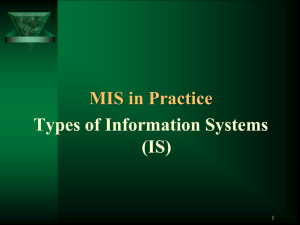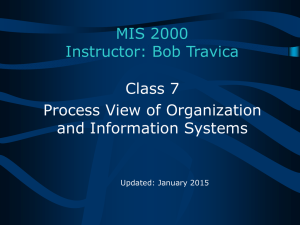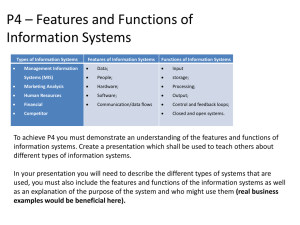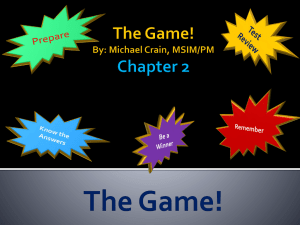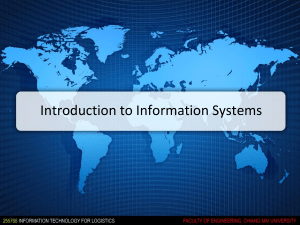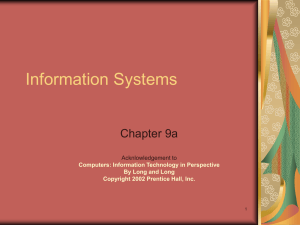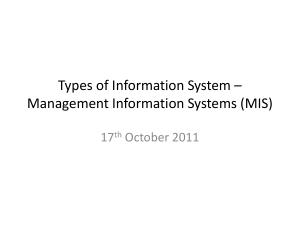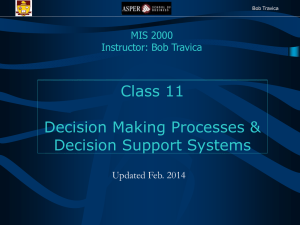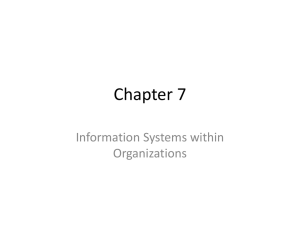Decision Making Processes and Decision Support Systems
advertisement
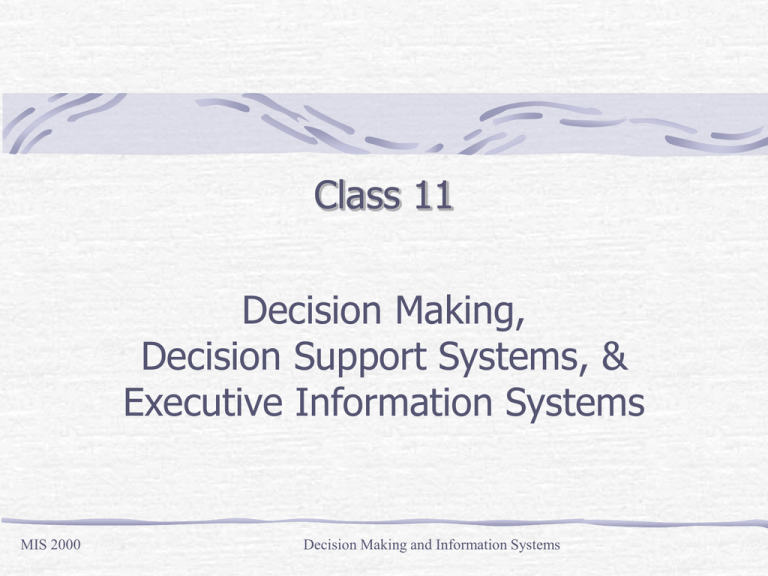
Class 11 Decision Making, Decision Support Systems, & Executive Information Systems MIS 2000 Decision Making and Information Systems Outline Decision making concepts Decision making and information systems Decision Support Systems (DSS) – upper level management Datamining – increasingly used data-driven DSS Executive Support Systems (ESS) MIS 2000 Decision Making and Information Systems 2 Decision Making* Decision making = problem solving by making choices. Stages in “Rational (Ideal, Scientific) Model” ** of decision making: Problem Definition: Collect data, learn & analyze Alternatives Solutions Creation: Figure out what courses of action could solve the problem Selection of best alternative: Evaluate alternatives on certain criteria and choose the best; this the decision Implementation: Put the decision into effect and evaluate effects Other Models (“good enough”, “Gut Feeling”, “Garbage Can”, etc.)* MIS 2000 Decision Making and Information Systems 3 Decisions and IS Types of problems to solve/decisions to make: Structured (well understood) – managing accounts receivable Unstructured (poorly understood, unknowns) – designing new product Semi-structured (some familiarity with problem) – budget preparation Information systems for decision making: TPS, MIS – previous lecture Decision Support Systems Executive Support Systems MIS 2000 Decision Making and Information Systems 4 Decision Support Systems DSS is a type of IS that supports mid-level and higher management in semi-structured decision making. Corporate financial planning (capital budgeting, scoring models) Product planning, Information systems planning; other planning* Supply chain management (production & shipping schedules) Customer relationship management (cross-selling, market segmentation) MIS 2000 Decision Making and Information Systems 5 Decision Support Systems DSS does: Support decision making steps (Problem, Alternatives) Improve speed and quality of decision making (better alternatives, more methodical). Consequences on organizational efficiency and effectiveness. MIS vs. - Routine or exceptional reports - Structured problems, general control MIS 2000 DSS - Semi Structured problems - Focus: Change, rapid response Decision Making and Information Systems 6 Types of DSS Model-driven DSS Systems that use some model for transforming data coming from TPS/MIS and external sources (e.g., “what-if” analysis; optimization models like Solver in Excel, etc.) – your Excel assignment Data-driven DSS Analyze data from TPS and external sources by using special software -Datamining is the main kind of IT used in data-driven DSS today (see next slides) MIS 2000 Decision Making and Information Systems 7 MIS vs. Data-Driven DSS MIS: Query: “How many units of product 420 were shipped last month?” Data retrieved from databases (TPS) to answer specific business questions Datamining : Automated analysis of hidden patterns & relationships TPS data are “cleaned” , integrated, and moved into Data Warehouse TPSs (data organized in tables; SQL used for search) MIS 2000 Data Warehouse (data organized differently) Decision Making and Information Systems 8 Datamining Used increasingly in marketing. Data analysis helps with identifying: 1. Associations: co-occurrence of events (e.g., does a consumer buys a group of same products at the same time; leads for cross-selling) 2. Sequences: identify events that are linked over time (e.g., after purchasing a new TV, within 3 months a DVD player is purchased 30% of the time; also cross-selling) 3. Classifications: identify patterns in data (e.g., determine buyers’ behaviour – happy customer, runaway customer) 4. Clusters: group related data to understand objects of interest (e.g., market segmentation on types of customers) MIS 2000 Decision Making and Information Systems 9 Executive Support Systems (ESS) ESS is an IS that supports top management in unstructured decision making. Helps senior executives to 1. Monitor and analyze organizational performance in order to identify opportunities and weaknesses relevant for improvement of the organization, and its efficiency and effectiveness 2. Develop business intelligence on competitors, future opportunities, and trends in order to define organizational strategies - goals and the paths of reaching the goals MIS 2000 Decision Making and Information Systems 10 ESS Data from external sources used extensively in ESS ESS has a drill-down capability, which helps an executive to understand what is behind aggregated performance figures User interface is graphics-intensive (next slide) MIS 2000 Decision Making and Information Systems 11 ESS Example Performance Analysis by using the method of Balanced Scorecard for monitoring and analyzing organizational performance (mixed quantitative & qualitative data - financial figures, productivity measures, customer & employee satisfaction) User interface is in the form of Executive Dashboard with scales/dials showing intensity of performance indicators. MIS 2000 Decision Making and Information Systems 12
